07-模块与包-1
模块与包
一、模块与包
模块
为了提高代码复用率,将一些定义的python程序保存到.py文件中,其他程序可以用import语句进行调用,此文件称为“模块”,模块的目的是为了其他程序进行引用。
- 模块是保存python程序的".py"文件
- 将模块中的对象引入到当前环境
#!/usr/bin/env python # -*- coding: utf-8 -*- """ # Author:ChengZi # Version:1.0 # Date:2021-01-28 21:42 # Filename: foo.py # Description:This script is used for """ def func_a(x,y): return x ** y f = func_a(10,2) print(f)
- 交互模式验证代码复用情况
#交互模式验证代码复用 PS F:\PyProject\pyscripts\project1\mymodule> python Python 3.7.6 (tags/v3.7.6:43364a7ae0, Dec 19 2019, 00:42:30) [MSC v.1916 64 bit (AMD64)] on win32 Type "help", "copyright", "credits" or "license" for more information. >>> >>> import foo >>> dir(foo) ['__builtins__', '__cached__', '__doc__', '__file__', '__loader__', '__name__', '__package__', '__spec__', 'f', 'func_a'] >>> foo.func_a(2,3) 8 >>> foo.func_a(5,3) 125
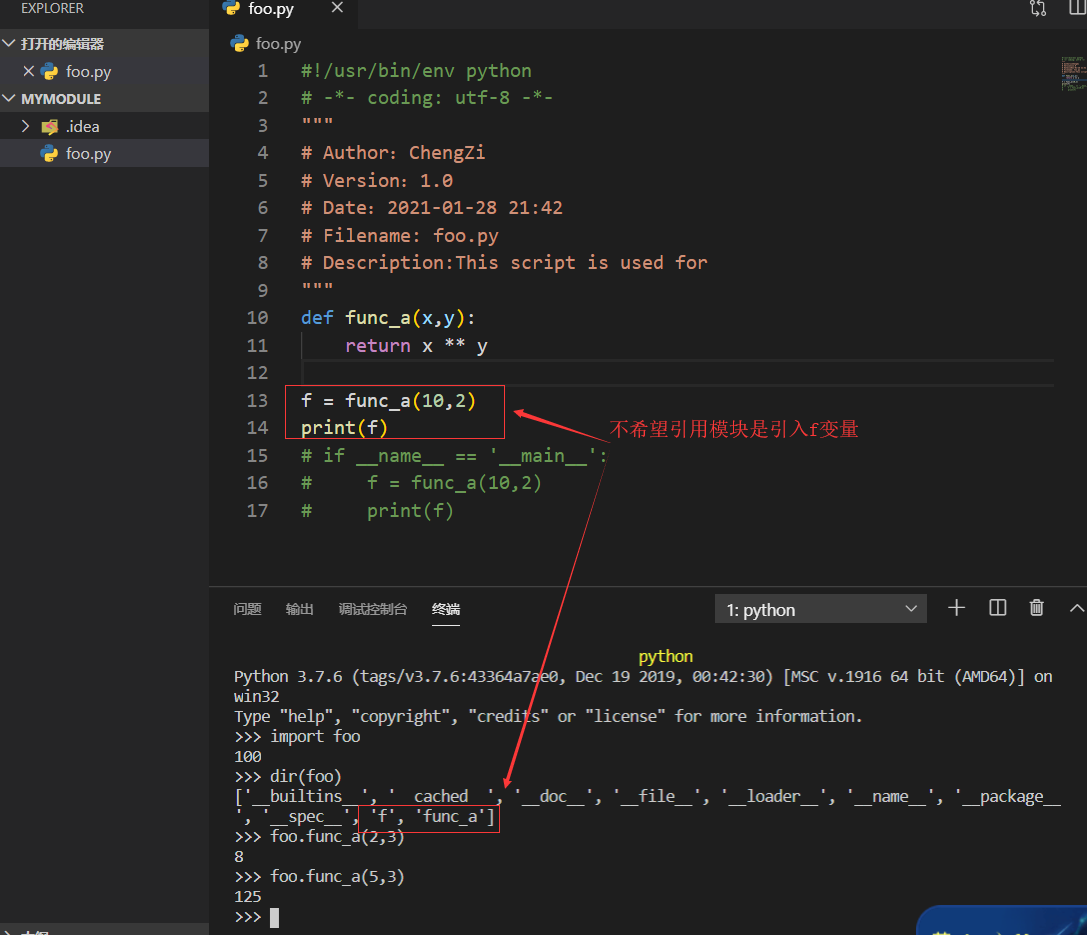
- 不希望在引入代码块是显示13、14行内容,则代码修改为如下:
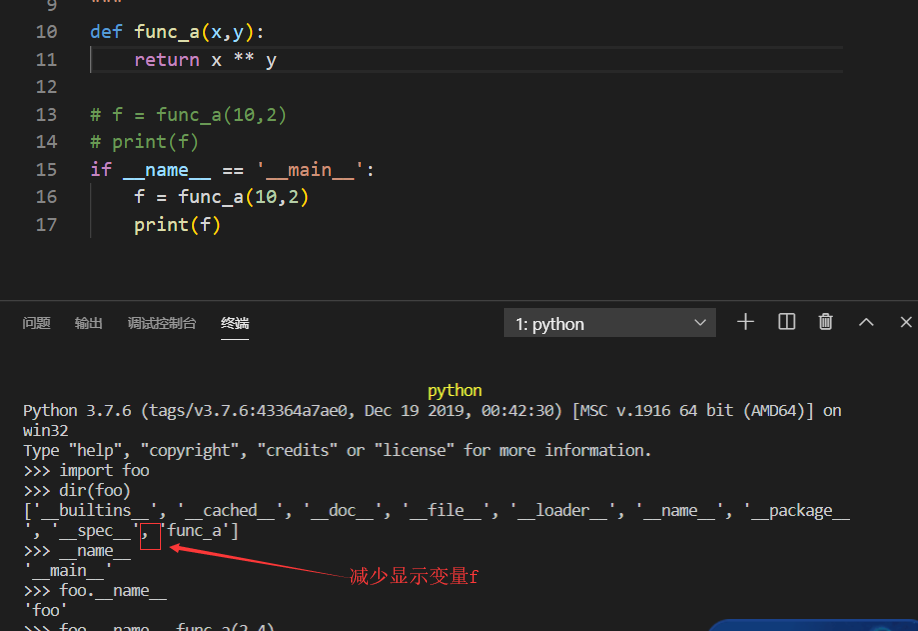
- __name__:
- 当前环境下,__name__的值是“__main__”。
- 在某个模块内,__name__的值是“模块名称”,例如foo。
- if __name__ == ''__main__":
- 相当于python模拟的“主程序入口”
- import语句及其变式
- import module1[,module2[module3[,..moduleN]]]
- from modulename import name1[,name2[,...nameN]]
- from modulename import *
- 命名别名:import modules as of othername
def func_a(x,y): return x ** y # f = func_a(10,2) # print(f) if __name__ == '__main__': f = func_a(10,2) print(f) print("foo.py is being run.") else: print("foo.py is being imported" #验证结果 PS F:\PyProject\pyscripts\project1\mymodule> python foo.py 100 foo.py is being run.
- 创建新文件bar.py,引入foo.py,验证结果
import foo f = foo.func_a(5,2) print(f) if __name__ == '__main__': print("bar.py is being run.") else: print("bar.py is being imported") #验证结果 PS F:\PyProject\pyscripts\project1\mymodule> python bar.py foo.py is being imported 25 bar.py is being run.
#引入模块示例 PS F:\PyProject\pyscripts\project1\mymodule> python Python 3.7.6 (tags/v3.7.6:43364a7ae0, Dec 19 2019, 00:42:30) [MSC v.1916 64 bit (AMD64)] on win32 Type "help", "copyright", "credits" or "license" for more information. >>> import foo,bar foo.py is being imported 25 bar.py is being imported >>> from foo import func_a >>> func_a(2,3) 8 >>> from foo import *
>>> import bar as b
- 引入模块的搜索路径顺序
- 内存中已经加载的模块
- 内置模块
- sys.path路径中包含的模块
#当前路径是在 F:\PyProject\pyscripts\project1\mymodule >>>python Python 3.7.6 (tags/v3.7.6:43364a7ae0, Dec 19 2019, 00:42:30) [MSC v.1916 64 bit (AMD64)] on win32 Type "help", "copyright", "credits" or "license" for more information. >>> import sys >>> sys.path ['', 'D:\\Program Files (x86)\\Python376\\python37.zip', 'D:\\Program Files (x86)\\Python376\\DLLs', 'D:\\Program Files (x86)\\Python376\\lib', 'D:\\Program Files (x86)\\Python376', 'D:\\Program Files (x86)\\Python376\\lib\\site-packages'] >>> import foo foo.py is being imported
#通过sys.path来使用新的路径,避免报错 PS F:\PyProject\pyscripts\project1\mymodule> cd ../ PS F:\PyProject\pyscripts\project1> dir 目录: F:\PyProject\pyscripts\project1 Mode LastWriteTime Length Name ---- ------------- ------ ---- d----- 2020/12/8 21:26 .idea d----- 2020/6/6 2:49 .vscode d----- 2020/12/26 0:36 20200210 d----- 2021/1/13 21:55 20200319 d----- 2021/1/21 18:46 20200524 d----- 2021/1/29 0:01 mymodule PS F:\PyProject\pyscripts\project1> python Python 3.7.6 (tags/v3.7.6:43364a7ae0, Dec 19 2019, 00:42:30) [MSC v.1916 64 bit (AMD64)] on win32 Type "help", "copyright", "credits" or "license" for more information. >>> import foo Traceback (most recent call last): File "<stdin>", line 1, in <module> ModuleNotFoundError: No module named 'foo' >>> import sys >>> sys.path.append("F:\PyProject\pyscripts\project1\mymodule") >>> dir <built-in function dir> >>> import foo foo.py is being imported
- .pyc文件
- 模块文件所在目录中的:__pycache__目录
- .pyc文件:将模块文件编译后,保存为此类文件
- 再次载入此模块(未修改),则装在此.pyc文件中
- 模块文件所在目录中的:__pycache__目录
包
包(package)是包含模块文件的目录
- 包里面有模块
- 保姆了内还有子目录
- 每层目录中,必须有:__init__.py
- 不是任何目录都是包,必须有:__init__.py标记的才是包
- 当包被引入时执行此文件
- 通常可以为空,也可以写一些初始化的代码,比如用__all__ == [ 'module_name' ,]的方式规定引入的内容
- 导入包的本质:就是执行这个包下面的__init__.py文件
- 包的示例
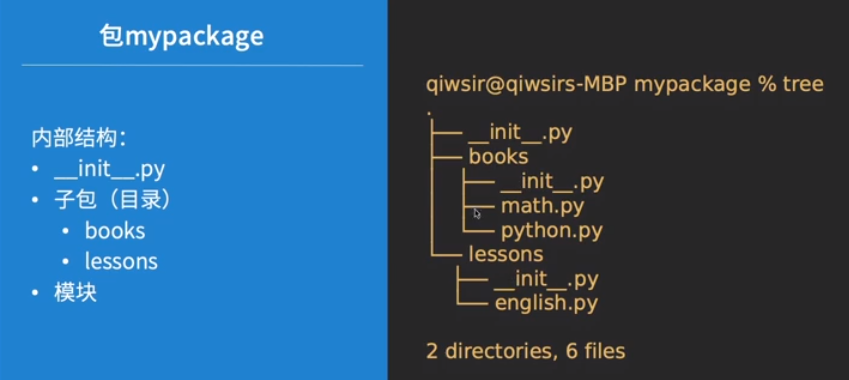
- 参考资料:https://www.cnblogs.com/janson071/p/10407459.html
二、pip和虚拟环境
什么是pip?
- pip是python中“包”(package)的管理工具
- 任何人都可以编写包,并发布
- 网站:https://pypi.org/
- 查看pip版本,并安装依赖包方式
#Windows环境: pip --version pip 19.2.3 from d:\program files (x86)\python376\lib\site-packages\pip (python 3.7) PS F:\PyProject\pyscripts\project1\mymodule> #linux环境 [oldboy@node3 ~]$ pip3 --version pip 19.0.3 from /usr/local/python3.7.4/lib/python3.7/site-packages/pip (python 3.7)
[oldboy@node3 ~]$ pip3 install package_name==1.4.3
[oldboy@node3 ~]$ pip3 install package_name>=1.4.3
- pip其他操作
#更新、升级 pip install package_name -U pip install --upgrade package_name #列表 pip list #删除或卸载 pip uninstall package_name #更新源(由于pypi源位于国外,若因网络问题可使用国内pip源) pip config set global.index -url https://pypi.tuna.tsinghua.edu.cn/
虚拟环境
- 为什么需要虚拟环境?
- python应用程序通畅会使用不在标准库内的软件包和模块,应用程序有时需要安装特定版本的库(包、模块)
- 系统中的python安装可能无法满足每个应用程序的要求
- 创建虚拟环境—解决需求相冲突
创建虚拟环境
- 方法1:使用virtualenv
- 安装virtualenv:pip3 install virtualenv --user
- 创建虚拟环境:
- 创建目录myvenv,并进入目录myvenv:mkdir myvenv && cd myvenv
- 创建虚拟环境:virtualenv -p python3 venv-one
- 参数说明:
- -p python3:知名当前虚拟环境所使用的的python版本
- venv-one:虚拟环境所在目录
- 进入虚拟环境目录venv-one,激活当前虚拟环境
- cd ~/myvenv/venv-one && source $(pwd)/bin/activate
- 在虚拟环境中操作:
- 查看当前环境的包:pip list
- 安装包:pip install novas
- 进入交互模式,测试:import novas
- 在非虚拟环境中,对比测试
- 退出虚拟环境:deactivate
[oldboy@node3 ~]$ pip3 install virtualenv --user [oldboy@node3 ~]$ mkdir myvenv && cd myvenv/ [oldboy@node3 ~/myvenv]$ virtualenv -p python3 venv-one [oldboy@node3 ~/myvenv/venv-one]$ ll total 4 drwxrwxr-x 2 oldboy oldboy 285 Jan 31 21:12 bin drwxrwxr-x 3 oldboy oldboy 23 Jan 31 21:12 lib -rw-rw-r-- 1 oldboy oldboy 275 Jan 31 21:12 pyvenv.cfg [oldboy@node3 ~/myvenv]$ cd ~/myvenv/venv-one && source $(pwd)/bin/activate (venv-one) [oldboy@node3 ~/myvenv/venv-one]$ (venv-one) [oldboy@node3 ~/myvenv/venv-one]$ pip pip pip-3.7 pip3 pip3.7 (venv-one) [oldboy@node3 ~/myvenv/venv-one]$ pip list Package Version ---------- ------- pip 21.0.1 polysh 0.4 setuptools 52.0.0 wheel 0.36.2 (venv-one) [oldboy@node3 ~/myvenv/venv-one]$ deactivate [oldboy@node3 ~/myvenv/venv-one]$ pip3 list Package Version ------------------ ------- appdirs 1.4.4 distlib 0.3.1 filelock 3.0.12 importlib-metadata 3.4.0 pip 19.0.3 polysh 0.4 setuptools 40.8.0 six 1.15.0 typing-extensions 3.7.4.3 virtualenv 20.4.1 zipp 3.4.0 You are using pip version 19.0.3, however version 21.0.1 is available. You should consider upgrading via the 'pip install --upgrade pip' command #虚拟环境的依赖包比系统层环境的要少很多 (venv-one) [oldboy@node3 ~/myvenv/venv-one]$ python Python 3.7.4 (default, Mar 29 2020, 02:42:02) [GCC 7.3.1 20180303 (Red Hat 7.3.1-5)] on linux Type "help", "copyright", "credits" or "license" for more information. #由于虚拟环境创建时指定了使用python3,故python交互模式默认是3.7.4 >>> exit() (venv-one) [oldboy@node3 ~/myvenv/venv-one]$ python3 Python 3.7.4 (default, Mar 29 2020, 02:42:02) [GCC 7.3.1 20180303 (Red Hat 7.3.1-5)] on linux Type "help", "copyright", "credits" or "license" for more information. >>> exit() (venv-one) [oldboy@node3 ~/myvenv/venv-one]$ python3 Python 3.7.4 (default, Mar 29 2020, 02:42:02) [GCC 7.3.1 20180303 (Red Hat 7.3.1-5)] on linux Type "help", "copyright", "credits" or "license" for more information. >>> import novas #系统层import novas报错 [oldboy@node3 ~]$ python3 Python 3.7.4 (default, Mar 29 2020, 02:42:02) [GCC 7.3.1 20180303 (Red Hat 7.3.1-5)] on linux Type "help", "copyright", "credits" or "license" for more information. >>> import navas Traceback (most recent call last): File "<stdin>", line 1, in <module> ModuleNotFoundError: No module named 'navas'
- 方法2:使用pyvenv
- python3.3以后,默认提供(缺点:不能指定虚拟环境所使用的的python版本)
- 在myvenv目录下,创建虚拟环境:pyvenv venv-two
- 进入venv-two,并激活:source $(pwd)/bin/activate
- 退出:deactivate
- 参考资料:
- https://www.linuxidc.com/Linux/2017-05/143685.htm
- https://www.cnblogs.com/dingtianwei/p/9383230.html
- 方法3:使用pipenv(集成方法1和pip)
- 安装:pip3 install pipenv && ln -sv $(find / -type f -name "pipenv") /usr/bin/pipenv
- 在myvenv目录下,创建虚拟环境:
- 创建新目录:mkdir venv-three && cd venv-three
- 声明使用python3:pipenv --three
- 查看当前虚拟环境的包:cat Pipfile
- 激活虚拟环境:
- 进入:pipenv shell
- 安装:pipenv install novas
- 退出:exit
[root@node3 ~]# pip3 install pipenv [root@node3 ~]# pip3 install -U pipenv [root@node3 ~]# cat .bashrc # .bashrc # User specific aliases and functions alias rm='rm -i' alias cp='cp -i' alias mv='mv -i' # Source global definitions if [ -f /etc/bashrc ]; then . /etc/bashrc fi #add pyvenv environment at 20210131 export PATH="/home/oldboy/.pyenv/bin:$PATH" eval "$(pyenv init -)" eval "$(pyenv virtualenv-init -)" [root@node3 ~]# source .bashrc [root@node3 ~]# find / -type f -name "pipenv" /usr/local/python3.7.4/bin/pipenv [root@node3 ~]# ln -sv /usr/local/python3.7.4/bin/pipenv /usr/bin/pipenv#创建pipenv全局环境 '/usr/bin/pipenv' -> '/usr/local/python3.7.4/bin/pipenv' [oldboy@node3 ~/myvenv]$ mkdir venv-three && cd venv-three#创建虚拟摸了 [oldboy@node3 ~/myvenv/venv-three]$ pipenv --three#表示虚拟环境python版本为python3 Creating a virtualenv for this project... Pipfile: /home/oldboy/myvenv/venv-three/Pipfile Using /usr/local/bin/python3 (3.7.4) to create virtualenv... ⠏ Creating virtual environment...created virtual environment CPython3.7.4.final.0-64 in 1431ms creator CPython3Posix(dest=/home/oldboy/.local/share/virtualenvs/venv-three-Pl0XrQjp, clear=False, no_vcs_ignore=False, global=False) seeder FromAppData(download=False, pip=bundle, setuptools=bundle, wheel=bundle, via=copy, app_data_dir=/home/oldboy/.local/share/virtualenv) added seed packages: pip==21.0.1, setuptools==52.0.0, wheel==0.36.2 activators BashActivator,CShellActivator,FishActivator,PowerShellActivator,PythonActivator,XonshActivator ✔ Successfully created virtual environment! Virtualenv location: /home/oldboy/.local/share/virtualenvs/venv-three-Pl0XrQjp Creating a Pipfile for this project... [oldboy@node3 ~/myvenv/venv-three]$ pipenv shell#进入虚拟环境 Launching subshell in virtual environment... . /home/oldboy/.local/share/virtualenvs/venv-three-Pl0XrQjp/bin/activate [oldboy@node3 ~/myvenv/venv-three]$ . /home/oldboy/.local/share/virtualenvs/venv-three-Pl0XrQjp/bin/activate (venv-three) [oldboy@node3 ~/myvenv/venv-three]$ pipenv install novas#在虚拟环境中安装novas包 Installing novas... Adding novas to Pipfile's [packages]... ✔ Installation Succeeded Pipfile.lock not found, creating... Locking [dev-packages] dependencies... Locking [packages] dependencies... Building requirements... Resolving dependencies... ✔ Success! Updated Pipfile.lock (43df3a)! Installing dependencies from Pipfile.lock (43df3a)... ▉▉▉▉▉▉▉▉▉▉▉▉▉▉▉▉▉▉▉▉▉▉▉▉▉▉▉▉▉▉▉▉ 0/0 — 00:00:00 (venv-three) [oldboy@node3 ~/myvenv/venv-three]$ pip --version pip 21.0.1 from /home/oldboy/.local/share/virtualenvs/venv-three-Pl0XrQjp/lib/python3.7/site-packages/pip (python 3.7) (venv-three) [oldboy@node3 ~/myvenv/venv-three]$ pip list Package Version ---------- ------- novas 3.1.1.5 pip 21.0.1 polysh 0.4 setuptools 52.0.0 wheel 0.36.2
三、内置模块
- python标准库非常庞大,所提供的组件涉及范围十分广泛;此外还有标准库之外的第三方库和包,构成了完整的应用开发框架。
- python官方中文文档:https://docs.python.org/zh-cn/library/index.html
os与sys模块
- os模块提供了非常丰富的方法,详情参考:
-
https://www.runoob.com/python3/python3-os-file-methods.html
-
https://www.cnblogs.com/mainstream/p/11275834.html
-
https://www.cnblogs.com/ginvip/p/6439679.html
-
os模块常用方法
文件操作
os.getcwd() #返回当前工作路径
os.path.isabs() #判断是否是绝对路径
os.path.isfile() #检验给出的路径是否是一个文件
os.path.isdir() #检验给出的路径是否是一个目录
os.sep #文件的路径分隔符 如:在windows上是 '\' 而在Linux上是 '/'
os.walk() #文件遍历 如:def file_name(file_dir): for root, dirs, files in os.walk(file_dir): print('root_dir:', root) # 当前目录路径 print('sub_dirs:', dirs) # 当前路径下所有子目录 print('files:', files) # 当前路径下所有非目录子文件 file_name('E:/vmware') os.path.splitext() #分离扩展名
os.system() #运行shell命令
os.path.exists() #检验给出的路径是否真地存
os.getenv() 与os.putenv() #读取和设置环境变量
os.linesep #给出当前平台使用的行终止符,如: windowss使用'\r\n' ,Linux使用'\n'而Mac使用'\r'
os.name #指示你正在使用的平台,如:对于Windows,它是'nt',而对于Linux/Unix用户,它是'posix'
os.chmod(file) #修改文件权限与时间戳
os.exit() #终止当前进程
目录操作
os.makedirs("file1/file2/file3") #创建文件夹目录. 创建多级目录 os.mkdir("file") # 创建文件夹. 但是上级目录必须存在 os.copy("oldfile","newfile") #oldfile只能是文件夹,newfile可以是文件,也可以是目标目录 os.rename("oldname","newname") #重命名文件(目录) 文件或目录都是使用这条命令 os.removedirs() # 删除多级目录, 要求必须是空的 os.rmdir("dir") #只能删除空目录 os.listdir() #返回指定目录下的所有文件和目录名 os.path.split(path) #返回一个路径的目录名和文件名 os.path.dirname() #获取路径名 os.path.basename() #获取文件名 os.path.getsize(filename #获取文件大小 os.chdir("path") #换路径
文件读写操作
os.remove() #删除文件 或空文件夹 os.stat() #获取文件属性 with open("abc.txt",mode="w",encoding="utf-8") as f: #写文件,当文件不存在时,就直接创建此文件 pass encoding #文件编码 mode #打开模式 name #文件名 #关于open 模式: w 以写方式打开, a 以追加模式打开 (从 EOF 开始, 必要时创建新文件) r 以读写模式打开 w+ 以读写模式打开 (参见 w ) a+ 以读写模式打开 (参见 a ) rb 以二进制读模式打开 wb 以二进制写模式打开 (参见 w ) ab 以二进制追加模式打开 (参见 a ) rb+ 以二进制读写模式打开 (参见 r+ ) wb+ 以二进制读写模式打开 (参见 w+ ) ab+ 以二进制读写模式打开 (参见 a+ ) lines = object_file.readlines( )#读第一行 for line in file_object:#如果文件是文本文件,还可以直接遍历文件对象获取每行: print(line)
- os模块常用方法实战:https://blog.csdn.net/xxlovesht/article/details/80913193
[oldboy@node3 ~]$ python3 Python 3.7.4 (default, Mar 29 2020, 02:42:02) [GCC 7.3.1 20180303 (Red Hat 7.3.1-5)] on linux Type "help", "copyright", "credits" or "license" for more information. >>> import os >>> os.listdir() ['.bash_logout', '.bashrc', '.bash_history', 'tools', '.ssh', 'scripts', 'polysh', '.vimrc', '.bash_profile', 'hostlist', '.python_history', '.rnd', 'pyscripts', '.cache', '.local', '.pki', '.pyenv', 'iplist', 'perl5', '.viminfo', 'myvenv']>>> os.listdir("/home/oldboy/") ['.bash_logout', '.bashrc', '.bash_history', 'tools', '.ssh', 'scripts', 'polysh', '.vimrc', '.bash_profile', 'hostlist', '.python_history', '.rnd', 'pyscripts', '.cache', '.local', '.pki', '.pyenv', 'iplist', 'perl5', '.viminfo', 'myvenv'] >>> os.listdir("/home/oldboy/myvenv") ['venv-one', 'venv-three'] >>> os.getcwd() '/home/oldboy' >>> os.chdir("tools") >>> os.getcwd() '/home/oldboy/tools' >>> os.chdir("../") >>> os.getcwd() '/home/oldboy' >>> import os >>> os.getcwd() '/home/oldboy' >>> os.makedirs('./newdir') >>> os.listdir("/home/oldboy/") ['.bash_logout', '.bashrc', '.bash_history', 'tools', '.ssh', 'scripts', 'polysh', '.vimrc', '.bash_profile', 'newdir', 'hostlist', '.python_history', '.rnd', 'pyscripts', '.cache', '.local', '.pki', '.pyenv', 'iplist', 'perl5', '.viminfo', 'myvenv'] >>> os.removedirs("./newdir") >>> os.listdir(".") ['.bash_logout', '.bashrc', '.bash_history', 'tools', '.ssh', 'scripts', 'polysh', '.vimrc', '.bash_profile', 'hostlist', '.python_history', '.rnd', 'pyscripts', '.cache', '.local', '.pki', '.pyenv', 'iplist', 'perl5', '.viminfo', 'myvenv'] >>> os.rename("tools","testfile") >>> os.listdir(".") ['.bash_logout', '.bashrc', '.bash_history', '.ssh', 'scripts', 'polysh', '.vimrc', '.bash_profile', 'hostlist', '.python_history', '.rnd', 'pyscripts', '.cache', '.local', '.pki', '.pyenv', 'testfile', 'iplist', 'perl5', '.viminfo', 'myvenv'] >>> os.rename("testfile","tools") >>> os.listdir(".") ['.bash_logout', '.bashrc', '.bash_history', '.ssh', 'scripts', 'polysh', '.vimrc', '.bash_profile', 'tools', 'hostlist', '.python_history', '.rnd', 'pyscripts', '.cache', '.local', '.pki', '.pyenv', 'iplist', 'perl5', '.viminfo', 'myvenv']
- python交互环境使用linux命令行shell模式
[oldboy@node3 ~]$ ls hostlist iplist myvenv perl5 polysh pyscripts scripts tools [oldboy@node3 ~]$ python3 Python 3.7.4 (default, Mar 29 2020, 02:42:02) [GCC 7.3.1 20180303 (Red Hat 7.3.1-5)] on linux Type "help", "copyright", "credits" or "license" for more information. >>> cmd = "ls " + os.getcwd() >>> cmd 'ls /home/oldboy' >>> os.system(cmd) hostlist iplist myvenv perl5 polysh pyscripts scripts tools 0
sys模块常用方法
- argv:实现从程序外部向程序传递参数。
import os,sys print("hello world!") print("current directory has abbove files:\n",os.listdir("./") #执行结果: PS F:\PyProject\pyscripts\project1\mymodule> python .\os_test_sys.py hello world! The directory has files: ['.idea', 'bar.py', 'foo.py', 'os_test_sys.py', '__pycache__'] PS F:\PyProject\pyscripts\project1\mymodule> python .\os_test_sys.py file name: .\os_test_sys.py length of argument 1 argument arg: ['.\\os_test_sys.py'] PS F:\PyProject\pyscripts\project1\mymodule> python .\os_test_sys.py -q 345 op file name: .\os_test_sys.py length of argument 4 argument are: ['.\\os_test_sys.py', '-q', '345', 'op'] #获取命令参数的作 import os,sys lam = lambda x,y: x + y x = float(sys.argv[1]) y = float(sys.argv[2]) print("x + y = ",lam(x,y)) #执行结果 PS F:\PyProject\pyscripts\project1\mymodule> python .\os_test_sys.py 3 5 x + y = 8.0 PS F:\PyProject\pyscripts\project1\mymodule> python .\os_test_sys.py 6 10 x + y = 16.0
- exit:程序中间的退出,arg=0为正常退出。
>>> cmd = "ls " + os.getcwd() >>> cmd 'ls /home/oldboy' >>> os.system(cmd) hostlist iplist myvenv perl5 polysh pyscripts scripts tools 0 >>> >>> import sys >>> sys.exit("leave python environment") leave python environment # exit()举例 n = 10 while n > 10: n -= 1 if n == 5: sys.exit() else: print(n)
- path:返回模块的搜索路径,初始化时使用PYTHONPATH环境变量的值
- stdout:错误输出
import os,sys class Redirect(): def __init__(self,stdout): self.stdout = stdout def write(self,s): self.stdout.write(s.lower()) old_stdout = sys.stdout sys.stdout = Redirect(sys.stdout)#sys.stdout为sys模块的标准化输出作为Redirect的参数 #sys.stdout变量与sys模块的方法重名,则覆盖 print("LEARN python with laoqi") #以下两行为恢复sys标准化输出 sys.stdout = old_stdout print("YOU RAISE ME UP") #执行结果 PS F:\PyProject\pyscripts\project1\mymodule> python .\os_test_sys.py learn python with laoqi YOU RAISE ME UP
- stdin:标准输入
# stdin举例 while True: try: # reading from sys.stdin (stop with Ctrl-D) number = input('Enter a number:') # number = sys.stdin.realine()[:-1] except EOFError: print('\nEND') break else: try: number = int(number) if number == 0: print('0 has no inverse') else: print('inverse of {0} is {1}'.format(number, 1.0/number)) except ValueError: print('\nEnd') break
- 参考资料
- https://www.jianshu.com/p/c1831232c391
- https://www.cnblogs.com/korol7/p/12831559.html
- https://www.cnblogs.com/zhangxinqi/p/7826872.html
- https://blog.csdn.net/swinfans/article/details/85780302
sys.argv #获取命令行参数列表,第一个元素是程序本身 sys.exit(n) #退出Python程序,exit(0)表示正常退出。当参数非0时,会引发一个SystemExit异常,可以在程序中捕获该异常 sys.version #获取Python解释程器的版本信息 sys.maxsize #最大的Int值,64位平台是2**63 - 1 sys.path #返回模块的搜索路径,初始化时使用PYTHONPATH环境变量的值 sys.platform #返回操作系统平台名称 sys.stdin #输入相关 sys.stdout #输出相关 sys.stderr #错误相关 sys.exc_info() #返回异常信息三元元组 sys.getdefaultencoding() #获取系统当前编码,默认为utf-8 sys.setdefaultencoding() #设置系统的默认编码 sys.getfilesystemencoding() #获取文件系统使用编码方式,默认是utf-8 sys.modules #以字典的形式返回所有当前Python环境中已经导入的模块 sys.builtin_module_names #返回一个列表,包含所有已经编译到Python解释器里的模块的名字 sys.copyright #当前Python的版权信息 sys.flags #命令行标识状态信息列表。只读。 sys.getrefcount(object) #返回对象的引用数量 sys.getrecursionlimit() #返回Python最大递归深度,默认1000 sys.getsizeof(object[, default]) #返回对象的大小 sys.getswitchinterval() #返回线程切换时间间隔,默认0.005秒 sys.setswitchinterval(interval) #设置线程切换的时间间隔,单位秒 sys.getwindowsversion() #返回当前windwos系统的版本信息 sys.hash_info #返回Python默认的哈希方法的参数 sys.implementation #当前正在运行的Python解释器的具体实现,比如CPython sys.thread_info #当前线程信息
正则表达式和re模块
正则表达式
- (regular expression,简写regexp,re),又称“规则运算式”,是描述某种规则的表达式;re模块使python语言拥有全部的正则表达式功能
- python中的正则表达式大致分为以下几部分
- 元字符
- 模式
- 函数
- re 内置对象用法
- 分组用法
- 环视用法
- 官方文档:https://docs.python.org/zh-cn/3/library/re.html
参考资料
https://www.cnblogs.com/huxi/archive/2010/07/04/1771073.html
https://www.cnblogs.com/tina-python/p/5508402.html
https://www.cnblogs.com/misswangxing/p/10736310.html
https://www.runoob.com/python/python-reg-expressions.html
基本语法
- 特殊字符:一些有特殊含义的字符,如runoo*b的*,表示任何字符串;若要匹配这些特殊字符,可使用反斜杠\放在前面进行转义。
- 限定符:指定正则表达式的一个给定组件必须达到多少次才满足匹配条件
- 定位符:将正则表达式固定在行首或行尾,定位符用来描述字符串或单词的边界,如^、$分别指字符串的开始与结束,\b描述单词的前或后边界,\B表示非单词边界。
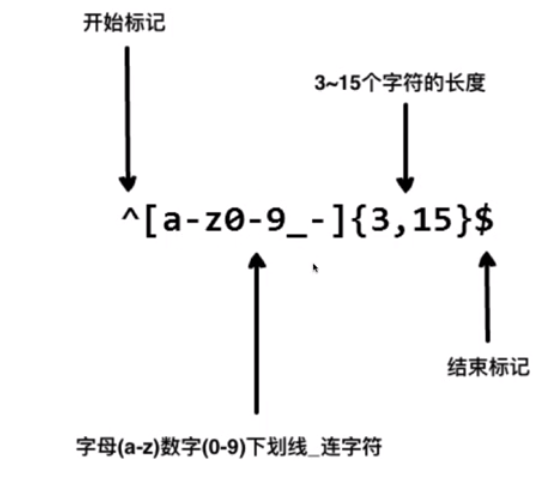

- 正则表达式模式
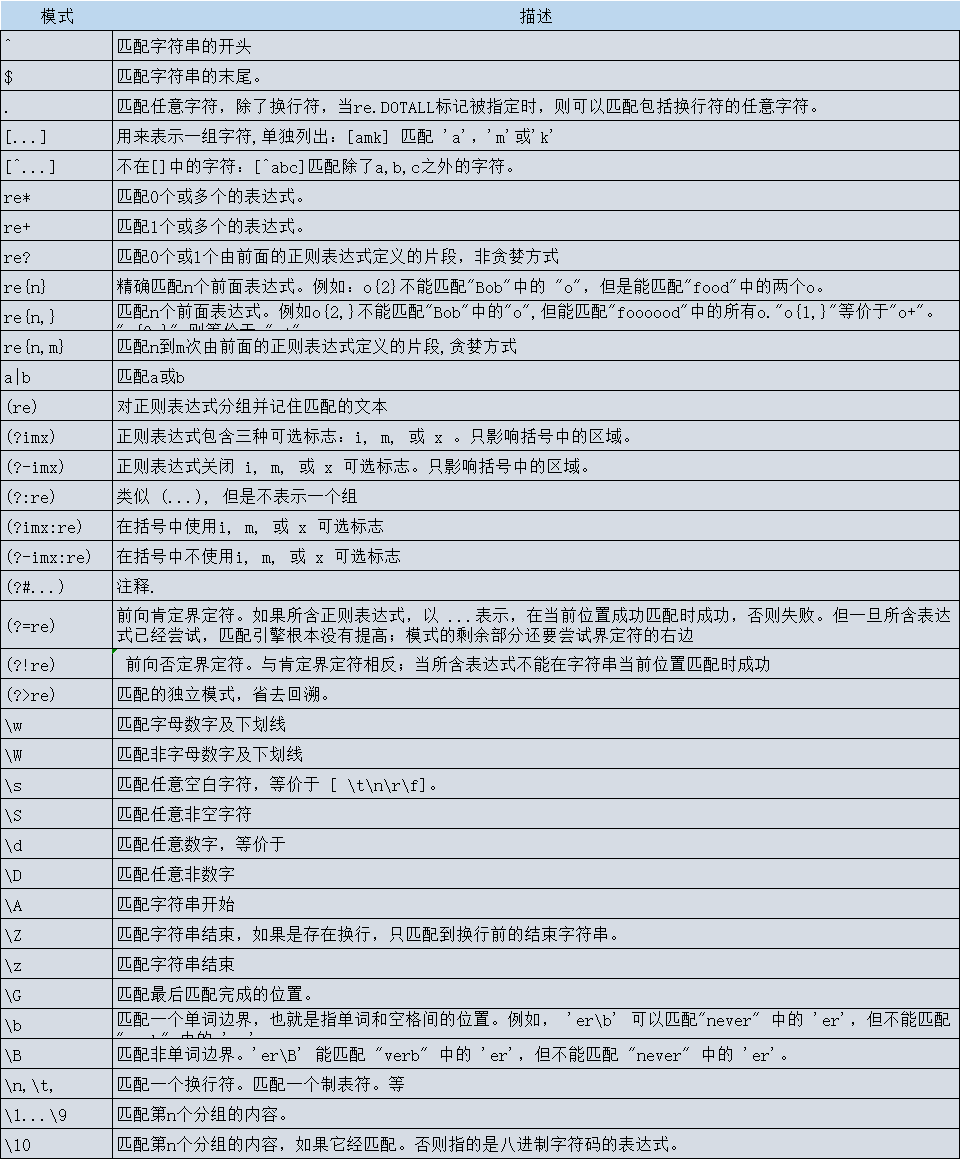
re模块常用函数
- match:尝试从字符串的起始位置匹配
- search:扫描整个字符串并返回第一个成功的匹配
[oldboy@node3 ~]$ python3 Python 3.7.4 (default, Mar 29 2020, 02:42:02) [GCC 7.3.1 20180303 (Red Hat 7.3.1-5)] on linux Type "help", "copyright", "credits" or "license" for more information. >>> import re >>> re.match('w*','www.google.com') <re.Match object; span=(0, 3), match='www'> >>> r = re.match('w*','www.google.com') >>> r.group() 'www' >>> re.match('com','www.google.com') >>> re.search('com','www.google.com') <re.Match object; span=(11, 14), match='com'> >>> s = 'It is 2020-02-04' >>> regx = '\d{4}-\d{1,2}-\d{1,2}' >>> re.search(regx,s) <re.Match object; span=(6, 16), match='2020-02-04'>
>>> import re >>> lst = ["dog dot","do don't","dumb-dumb","no match"] >>> for ele in lst: ... m = re.match('(d\w+)\W(d\w+)',ele) #dog和dot之间有空字符,dumb和dumb之间有-,所以w表示字母,+表示多个,W(大写)表示非字母 ... if m: ... print(m.groups()) ... ('dog', 'dot') ('do', 'don') ('dumb', 'dumb') #group与groups比较 >>> m = re.match(r'(\w+)@(\w+)\.(\w+)','username@hackerrank.com') >>> m.group() 'username@hackerrank.com' >>> m.groups() ('username', 'hackerrank', 'com') >>> m.group(0) 'username@hackerrank.com' >>> m.group(1) 'username' >>> m.group(2) 'hackerrank' >>> m.group(3) 'com' >>> m.group(1,2,3) ('username', 'hackerrank', 'com') >>> m = re.match(r'(?P<user>\w+)@(?P<website>\w+)\.(?P<extension>\w+)','myname@hackerrank.com') >>> m.groupdict() {'user': 'myname', 'website': 'hackerrank', 'extension': 'com'}
- sub:用于替换字符串中的匹配项
>>> import re >>> n = '2019-11-11' >>> re.sub(r'\D','',n) '20191111' >>> s = 'It is 2020-11-11' >>> re.sub('\d{4}-\d{1,2}-\d{1,2}','2021-02-01',s) 'It is 2021-02-01'
- compile:用于编译正则表达式,生成一个正则表达式(pattern)对象,供match()和search()函数使用
- findall:在字符串中找到正则表达式匹配的所有子窜,并返回一个列表;若没有找到匹配的,则返回空列表
>>> s = 'sdfjal2325jsdab-td908,700daog' #查找数字 >>> re.findall('\d+',s) ['2325', '908', '700'] #查找非数字 >>> re.findall('\D+',s) ['sdfjal', 'jsdab-td', ',', 'daog'] #查找非数字和字母 >>> re.findall('\W+',s) ['-', ','] #查找数字和字母 >>> re.findall('\w+',s) ['sdfjal2325jsdab', 'td908', '700daog']
- split:按照能够匹配的子串将字符串分割后返回列表
#split分割 >>> 'you need python'.split() ['you', 'need', 'python'] >>> value = 'one 1 two 2 three 3' >>> result = re.split('\D+',value)#大写D表示已非数字作为分隔符 >>> result ['', '1', '2', '3'] >>> lang = 'life is short,you need python.' >>> lang.split() ['life', 'is', 'short,you', 'need', 'python.'] >>> re.split('\W+',lang)#大写W表示非字母 ['life', 'is', 'short', 'you', 'need', 'python', ''] >>> re.findall('\w+',lang)#小写w表示字母 ['life', 'is', 'short', 'you', 'need', 'python']
日志模块logging
- 参考资料
- https://blog.csdn.net/pansaky/article/details/90710751
- https://www.cnblogs.com/xianyulouie/p/11041777.html
- https://www.cnblogs.com/liujiacai/p/7804848.html
- 日志是一种可以追踪某些软件运行时所发生时间的方法,部署项目时不可能直接将所有信息输出到屏幕,而是记录到日志文件中,方便追踪程序运行状况和故障排查
- logging模块默认的日志级别

- 日志级别大小关系:CRITICAL > ERROR > WARNING > INFO > DEBUG > NOTSET
- logging日志常用函数
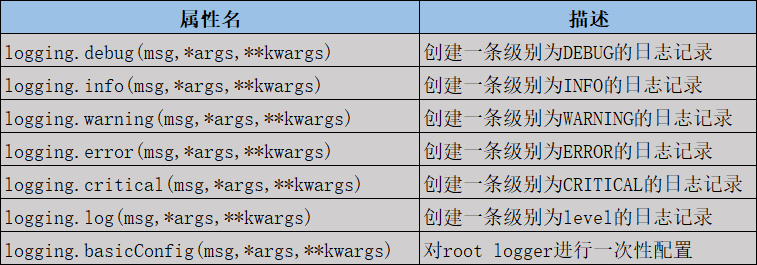
>>> import logging >>> logging.warning("watch out!") #warning级别,有自定义输出 WARNING:root:watch out! >>> logging.info("I told you so.") #info级别比warning级别低,故不输出 >>> logging.error("a big error") ERROR:root:a big error #只有级别是warning或以上的,才会输出;root是日志记录器的名称
示例1:使用logging提供的模块级别函数完成简单的日志记录
提示:只有级别大于或等于日志记录器指定级别的日志记录才会输出,小于该级别的日志记录将被丢弃
#!/usr/bin/env python # -*- coding=utf-8 -*- import logging # logging.info("This is a info log.") # logging.debug("This is a debug log.") # logging.warning("This is a warning log.") # logging.error("This is a error log.") # logging.critical("This is a critical log.") #等价于以下命令输出 logging.log(logging.DEBUG,"This is a info log.")#调用logging.log函数,参数内指定日志级别 logging.log(logging.INFO,"This is a debug log.") logging.log(logging.WARNING,"This is a warning log.") logging.log(logging.ERROR,"This is a error log.") logging.log(logging.CRITICAL,"This is a critical log.") #输出结果2 PS F:\PyProject\pyscripts\project1\mymodule> python .\logging_level.py WARNING:root:This is a warning log. ERROR:root:This is a error log. CRITICAL:root:This is a critical log.
- 自定义输出日志格式
import logging # 引入logging模块 logging.basicConfig(level=logging.DEBUG, format='%(asctime)s - %(filename)s[line:%(lineno)d] - %(levelname)s: %(message)s')
# logging.basicConfig函数对日志的输出格式及方式做相关配置 # 由于日志基本配置中级别设置为DEBUG,所以一下打印信息将会全部显示在控制台上 logging.info("This is a info log.") logging.debug("This is a debug log.") logging.warning("This is a warning log.") logging.error("This is a error log.") logging.critical("This is a critical log.")
#输出结果 S F:\PyProject\pyscripts\project1\mymodule> python .\logging_level.py 2021-02-05 16:35:16,392 - logging_level.py[line:15] - INFO: This is a info log. 2021-02-05 16:35:16,397 - logging_level.py[line:16] - DEBUG: This is a debug log. 2021-02-05 16:35:16,397 - logging_level.py[line:17] - WARNING: This is a warning log. 2021-02-05 16:35:16,398 - logging_level.py[line:18] - ERROR: This is a error log. 2021-02-05 16:35:16,398 - logging_level.py[line:19] - CRITICAL: This is a critical log.
- 日志系统的基本配置
- logging.basicConfig(**kwargs)
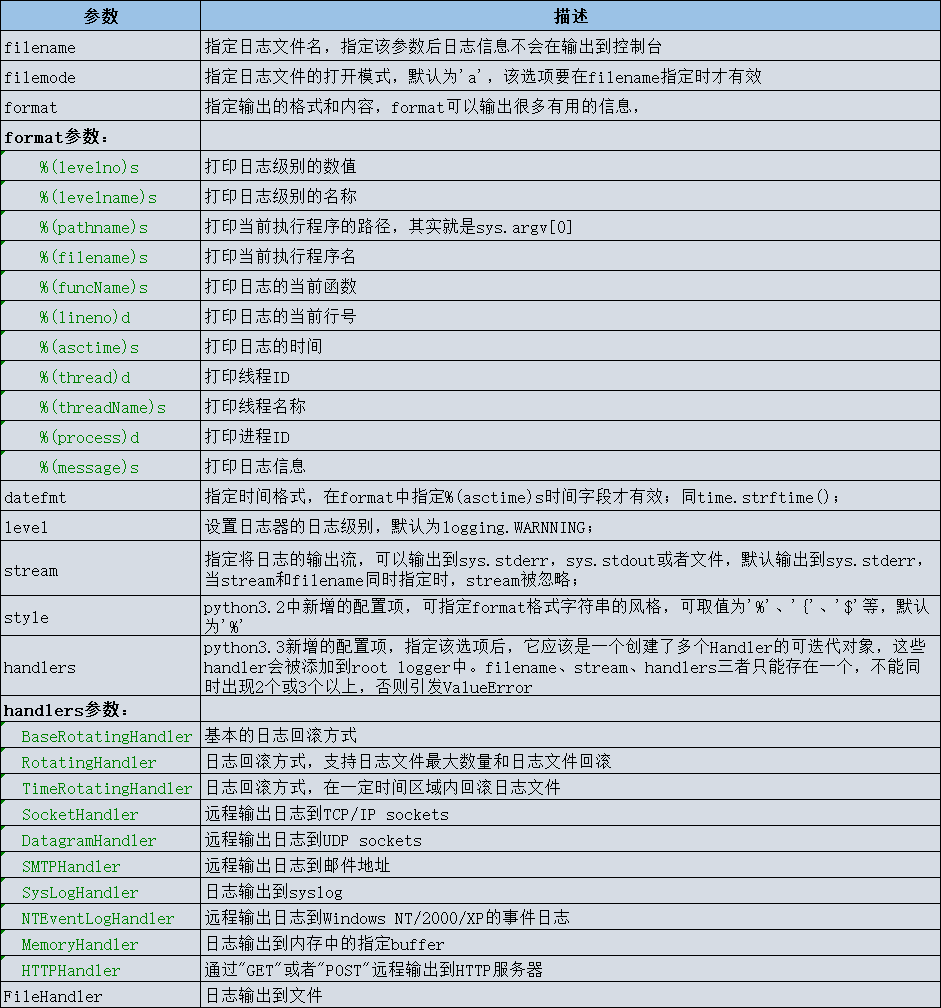
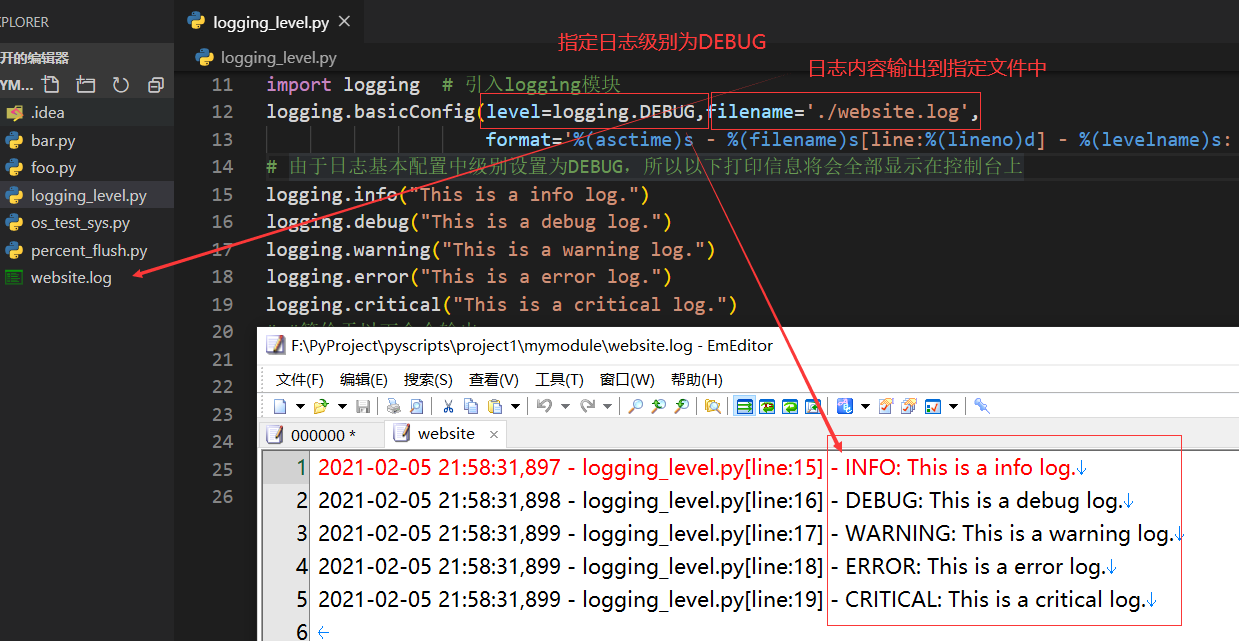
- logging模块的四类组件

- Logger(日志器/记录器)
- 向程序代码提供了几种方法,以便程序在运行时可以记录消息
- 根据严重性(默认过滤工具)或过滤对象,确定要处理的日志消息
- 将相关的日志消息传递给所有感兴趣的日志处理程序
- 常用方法:
- 配置方法
- 消息发生方法
- Logger实例对象常用的配置方法
- 通过logger类实例化
- 常用logging.getLogger()

- Handler(处理器)
- (基于日志消息的level)将消息分发到handler指定的位置(文件、网络、邮件等)
- Logger对象可以通过addHandler()方法添加0个或多个handler对象

- Formatter(格式器)
- 用于配置日志信息的最终顺序、结构和内容
- Formatter类的初始化方法定义如下:
- logging.Formatter.__init__(fmt=None,datefmt=None,style='%')
- fmt:指定消息格式化字符串,默认为message的原始值
- datefmt:指定日期格式化字符串,默认为"%Y-%m%-d %H:%M:%S"。
- style:可取值为'%','{'和'$',默认你'%'。
- logging.Formatter.__init__(fmt=None,datefmt=None,style='%')
示例2:自定义日志对象,并灵活设置不同日志器的等级
官方文档:https://docs.python.org/zh-cn/3/howto/logging.html
import logging import logging.handlers # 创建一个日志器/记录器 logger = logging.getLogger('logger') # 创建两个处理器 handler1 = logging.StreamHandler() # 将日志消息发送到输出到Stream,如标准输出 handler2 = logging.FileHandler(filename='./test.log') # 将日志消息发送到文件 # 设置日志器处理的日志信息的最低级别 logger.setLevel(logging.DEBUG) # 设置处理器的日志信息的最低级别 handler1.setLevel(logging.WARNING) handler2.setLevel(logging.DEBUG) # 输出格式 formatter = logging.Formatter('%(asctime)s %(name)s %(levelname)s %(message)s') handler1.setFormatter(formatter) # 不同处理器的输出格式 handler2.setFormatter(formatter) # 设置日志器所使用的处理器,将同一条日志输出到不同位置 logger.addHandler(handler1)#按标准输出,显示到屏幕上 logger.addHandler(handler2)#输出到文件test.log中 # 注意,这里使用自定义的logger的输出方法,不要使用logging.debug() logger.debug('This is a customer debug message') logger.info('This is a customer info message') logger.warning('This is a customer warning message') logger.error('This is a customer error message') logger.critical('This is a customer critical message') #屏幕输出结果 PS F:\PyProject\pyscripts\project1\mymodule> python .\custom_log_output.py 2021-02-05 23:59:38,794 logger WARNING This is a customer warning message 2021-02-05 23:59:38,795 logger ERROR This is a customer error message 2021-02-05 23:59:38,795 logger CRITICAL This is a customer critical message #文件输出结果
- 显示更复杂的日志格式
import logging FORMAT = '%(asctime)-15s %(clientip)s %(user)-8s %(message)s' logging.basicConfig(format=FORMAT) d = {'clientip': '192.168.0.1', 'user': 'laoqi'} logging.debug('This is a debug log.', extra=d) logging.info('This is a info log.', extra=d) logging.warning('This is a warning log.', extra=d) logging.error('This is a error log.', extra=d) logging.critical('This is a critical log.', extra=d) #屏幕输出 PS F:\PyProject\pyscripts\project1\mymodule> python .\custom_log_output.py 2021-02-06 07:28:35,647 192.168.0.1 laoqi This is a warning log. 2021-02-06 07:28:35,647 192.168.0.1 laoqi This is a error log. 2021-02-06 07:28:35,648 192.168.0.1 laoqi This is a critical log.








 浙公网安备 33010602011771号
浙公网安备 33010602011771号